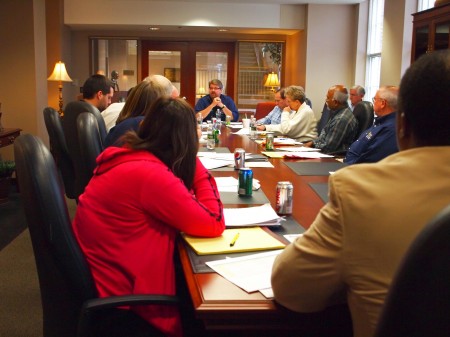
As the University enters the 10th week of the fall semester, the budget planning and review teams established by President Randy Dunn have begun prioritizing and evaluating academic and nonacademic programs.
The teams were established to reduce or re-appropriate funds to make up for a state-made $2,289,600 deficit to the University budget.
Josh Jacobs, chief of staff, said there has been no set number established by the president’s office or the Board of Regents, for how much each team should cut, but he said, the board indicated the administration should not rely on reserves for the coming year, as they did for this year’s budget.
“The board approved the use of approximately $1.9 million of reserves for 2012-13,” he said.
The Board of Regents annually reviews recommendations from Dunn, including those in regards to the University budget.
“This year, the president will make a recommendation to the board based on the activity of the teams and the work of the administration,” Jacobs said.
While no set number exists, he said the board and the president expect the review teams to take their charge seriously, which will result in savings and revenue for the University.
Jacobs said the president’s office has provided no strict metric or guideline the teams are to use.
“We did provide examples from other institutions that the teams could reference,” he said. “But we did not dictate a standard document.”
He said the metrics created by the teams need to loosely address five guiding criteria.
“1. Essentiality – History, size, scope, relationship to mission and overall essentiality to the institution; 2. Demand – External and internal demand, including enrollments and numbers served; 3. Quality – For program inputs, outputs and process quality; 4. Cost Effectiveness – Revenues and other resources generated against all costs associated with the program, including standard productivity measures; and 5. Opportunity – Impact, justification and expansion prospects,” Jacobs said.
On Oct. 16, a meeting was held in which the budget planning and review team chairs met with President Dunn to touch base and report preliminary suggestions.
“We wanted to reiterate the charge,” Jacobs said. “(To) allow the chairs to ask any questions, as well as have the opportunity to discuss any items as a group.”
Jacobs said the questions asked at the meeting included how to deal with the overall process moving forward. He said the members of the teams also asked about the process they should employ to clarify any jurisdictional questions for programs that may provide a service to the community or campus, but are also academic in nature.
Dunn said each academic and nonacademic team determines its own meeting time and frequency.
While no set dates have been established on the progress of the teams, the president’s office has set a general timeline, which includes an interim report to the Board of Regents at its Dec. 14 meeting.
Tim Todd, dean of the Arthur J. Bauernfeind College of Business and chair of the college’s budget planning and review team, said the teams have been more successful than he’d originally imagined.
“We’re basically going through three steps,” he said. “We’re prioritizing, looking to see if low performing programs need to be changed, we’re going through the budget to minimize the red ink, looking to see if we can innovatively change programs without damaging them and we’re looking to see if we can maximize the black ink, looking to provide more services which will show additional streams of revenue.”
Todd said the chairs within the school of business have been making their own recommendations, which the team is looking at before eventually making proposals to the provost and president.
“We’re literally taking the budget and going line-by-line,” he said. “We’re ‘scrubbing the budget’ to see areas that might be cut. We’re hoping we have strong recommendations to take the president in a month.”
Tom Denton, vice president of Finance and Administrative Services, said there were several things the teams could look at in regard to lessening expenditures.
He said one option might be looking at vacant salaried positions throughout the University.
“Out of the salaried positions in the budget, about 5 percent of them might be vacancies,” he said “But the vacancies on the academic side tend to stay in the budget longer.”
He said in previous years the academic side of the University has eliminated vacant positions to provide a source of funds, but only the positions that were empty for two or more years. He said the nonacademic salaried positions generally tended to fill quicker.
“It’s a never-ending process,” Denton said. “It’s difficult to maintain a static level of personnel. We have some vacancies year round and those will probably be looked at.”
Bonnie Higginson, vice president of Academic Affairs, said the budget was created earlier in the year and does not account for the positions that have since been filled.
“I would hope we don’t sweep vacant lines,” she said. “Academic Affairs did that before, and we lost over $700,000. I hope that doesn’t happen again, definitely not to that extreme.”
Story by Chris Wilcox, News Editor.